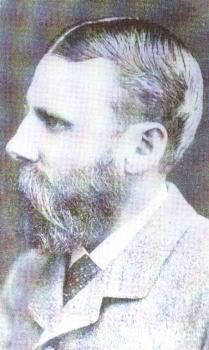

This account from the Century magazine of the Battle of Manila Bay was written by Commander E. P. Wood of the gunboat PETREL. The account is in the form of a letter, responding to an account by Colonel George Loud of the Revenue Cutter McCULLOCH which had appeared in an earlier issue of the Century magazine.
The Account:
October 1, 1898.
 DEAR MR. LOUD: I thank you very
much for remembering me with a copy of the August CENTURY MAGAZINE,
containing your article on the battle of Manila Bay.
It is most interesting, and altogether the best account which I have
read.
DEAR MR. LOUD: I thank you very
much for remembering me with a copy of the August CENTURY MAGAZINE,
containing your article on the battle of Manila Bay.
It is most interesting, and altogether the best account which I have
read.
I hope you will pardon me if I say I hardly think you fully appreciate the part performed by the PETREL during the latter part of the action. We passed inside of the line of battle, in obedience to a signal from the flagship, bearing across Canacao Bay toward the arsenal. When the Spanish flag was hauled down at the arsenal, the PETREL was within three hundred yards of the arsenal dock, and anchored. There she remained until 5:20 A. M., and with one boat’s crew burned seven vessels of war in the face of the military garrison in Cavite and the remnants of the ships’ crews that had been formed into infantry companies, armed with Mauser rifles. Had they chosen to resist, they could have supported their infantry fire with artillery, as the smooth-bore guns mounted at the arsenal were loaded, and would have done damage to the ship at the short range. The only boat immediately available “to burn and destroy the enemy’s ships” was a small whale-boat carrying an officer and seven men. With this boat Lieutenant Hughes, the executive officer, landed at the arsenal to place a signalman, and proceeded to burn five of the seven ships. The two remaining were burned later by Ensign Fermier. The MANILA was not burned, for the reason that Spanish officers at the arsenal said she was a surveying vessel, not a fighting ship, and was unarmed. The latter statement was untrue, for she had three machine- guns and two six-pounders, rapid-firing, which might have been used against us. A party from this vessel succeeded in getting her out two days later. She is now in commission as a United States war-vessel, and is doing efficient service.
After Lieutenant Hughes, with his party, left the PETREL, the steam whale-boat was prepared and sent ashore in charge of Lieutenant [Bradley] Fiske, the navigator, in support of the first boat. While lying at the dock, he secured two tugs and three steam-cutters, and towed them to the ship. They are all doing service with the fleet today.
These operations were beyond your range of vision—in fact, were not in sight of any one, as they took place behind the mole of the arsenal. It was only toward evening when the ascending columns of smoke showed results, and my appearance in the fleet with a long tow of tugs, steam- cutters, and other boats showed that the PETREL had not been idle that long and hot afternoon.
The action of Lieutenant Hughes in setting fire to the enemy’s sunken ships in the face of a well-armed, superior, but demoralized force, was the one act of conspicuous gallantry which the battle that day afforded. The action of Lieutenant [Bradley] Fiske was only less so for the reason that Hughes was the pioneer. While Hughes merely touched the arsenal to communicate and land a man, Fiske lay at the wharf for two hours or more, preparing the seized boats for coming off. It is my opinion that the Spanish authorities thought that we would be satisfied with seeing their ships sunk, and would not attempt further destruction; that when we departed they could close the outboard valves, pump them out, and the ships would be as good as new. They were too demoralized by the morning fight to offer any resistance.
I deem it due to all, both officers and men, that the performances of the PETREL, out of sight behind the arsenal, should be known. We are now looking forward to the time when we, like the Santiago fleet, may return to New York and enjoy the fruits of our hard work.
Very sincerely yours,
E. P. Wood.
Wood, E. P., Commander, USN, "The Battle of Manila Bay," The Century. Vol. 57, No. 6 (New York: The Century Company, April, 1899) 957-958.